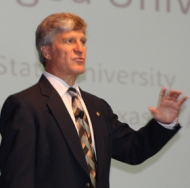NOSC 2012: The Kevin & Kevin Show– MUST SEE Presentation
When Kevin Foster and Kevin Kecskes took the podium this morning to kick off the final day of the 13th National Outreach Scholarship Conference, I was full of anticipation.

Kevin Kecskes from Portland State University was one of two engaged scholars named “Kevin” who gave the breakfast keynote on the third and final day of NOSC 2012.
This was the keynote event especially for faculty.
Even Kecskes started off a little slow with a lot of apologies about how difficult it is to give a keynote to a crowd at the early 8 a.m. hours, he and his first namesake, Kevin Foster delivered BIG!
Multi-speaker keynotes or panels can sometimes be very dry and quite frankly, boring. There’s one PowerPoint after another PowerPoint and if there’s not a real compelling moderator to tie together, the conference session falls FLAT.
From review of the models of community engagement to the continuum of change, Kecskes and Foster opened up a discussion that we hope to continue this afternoon. They inspired me to think again about what I do as both a community engaged scholar and as a faculty member in journalism.
I left this morning’s session with an expanded vocabulary to apply to what I do with new words such as contextual intervention and structural transformation.
“This work is political,” said Kesckes, who serves as associate provost for engagement and director of community-university partnerships at Portland State University. “Change is political.”
While Kesckes made some great points, I believe I connected with Foster even more, in part because he was very transparent about his journey as a scholar from historically underrepresented population.
 “I’ve had to figure out how to make it in the academy, ” Foster admitted as he shared his experience knowing that he had to be better than all of his colleagues (presumably because of his engagement scholarship approach)
“I’ve had to figure out how to make it in the academy, ” Foster admitted as he shared his experience knowing that he had to be better than all of his colleagues (presumably because of his engagement scholarship approach)
Because community-engaged scholarship is so new to the academy, it does require a sales job.
One of the selling points that was raised at today’s kick-off is the fact that community-engaged scholarship is not easier, but harder to produce than more traditional scholarship or research. It requires the extra effort be made to include the community in all phases of the scholarly process.
Days Like Today Make An Alabama Professor Proud

Nine Ph.D. students from University of Alabama College of Communication and Information Sciences traveled to Norman, Okla. this weekend to present a total of 14 research papers. (Not Pictured is Elmie Nekmat, who missed our group photo)
NORMAN, Okla.— The beginning of March also signals the beginning of spring academic conference season.
As inconvenient as they are in the middle of a busy semester, these short, usually two-day gatherings are a chance to get feedback on research projects in-progress and catch up with colleagues at other colleges and universities.
I could not have been prouder as a teacher than I was today to see our students from the University of Alabama College of Communication and Information Sciences presenting their academic papers at this AEJMC Midwinter Conference, which is being held this weekend on the beautiful campus of the University of Oklahoma.
One of those students, Natalie Brown, is one the fast track, entering our Ph.D. program without even completing her master’s degree. She and I presented a research paper on our ongoing research on CNN’s Black in America franchise.
Then there’s Alice Tunaru, who just a few years ago sat in my undergraduate introductory journalism course as a scholar athlete. Today she was talking about how young adults access sex-related information online.
I just met Sim Butler and Betsy Emmons last semester when I visited the newest cohort in our Ph.D. program. As first-year doctoral students they shared their research on Mississippi State’s University’s efforts to use the #HAILSTATE Twitter hashtag during their recent beat-down on rival Ole Miss last Thanksgiving weekend.
I believe I counted 14 papers that were presented by our graduate students (and one faculty member) at this conference this weekend, That’s same number of papers as were presented by faculty and students at our host institution, OU.
What an accomplishment! Seeing all of this in the plush quarters of the Gaylord College of Journalism and Mass Communication make it all the more thrilling.
Roll Tide!
Reason #1- To tell us where the candidates stand
It’s a midterm election year and lots of states like Alabama are not only elected members of Congress, but also governors and individuals to other statewide offices.
Here in Alabama, we have already held a primary for many of the statewide races. But, there is an upcoming run-off election on July 13, 2010.
Besides Republican voters deciding on a candidate for governor, Democratic voters in my Congressional District (Alabama’s 7th) will have to decide between two African American women as the nominee. They are Sheila Smoot and Terri Sewell.
The Birmingham News’ Washington Correspondent Mary Orndorff exemplifies the reason we need journalists.
In her story “How Sewell, Smoot stand on the issues,” she outlined each of the candidates’ positions on jobs, health care, debt, war, and energy.
Orndorff is showing how journalists act as the independent monitor of power, which was suggested as one of the elements of journalism.
At the time of this posting, Orndorff is further exemplifying this importance of journalists in her coverage of the confirmation hearings of Elena Kagan.
Read her postings on her Sweet Home Potomac blog.
WHY 101 Reasons?
In August 2010, the University of Alabama Department of Journalism will debut a new 1-credit course designed to enlighten and excite a new generation of students about journalism.
I need examples! Current examples!
I read a lot of newspapers, look at a lot of news magazines and news programs. I know we need journalism.
But, I believe THIS YEAR– in 2010– I can find 101 reasons WHY we need journalism.
In the midst of sharing a little about journalism history, a little about journalistic writing styles, a little about how laws and policy affect journalism and the ethical way we do we do, I want to share the GOOD NEWS of the GOSPEL of JOURNALISM.
I believe we as journalism advocates are journalism evangelists. Our calling is to spread the gospel and in the process, win over some new converts. They may be students at a university, middle or high school students or even — and often most importantly– members of the general public who have become distrusting of journalists.
This blog will help me on track with my journey to find these examples. It will also keep it organized and documented in one place.
Once it gets going, I am believing some great journalists out there will take the time to send me examples of good journalism that they know about and should be showcased.
For each of the 101 reasons, there are some basic requirements, I have to be able to link to the reason on the WEB. I also have to be able to determine by reading the journalism that it reflects the tenets of great journalism– truthful, well-sourced, complete and has the potential to make a difference.
We see a lot of news stories out there, but they don’t always have much potential to make a difference.
In our class, we point to what are now 10 Elements of Journalism developed several years ago by the Committee for Concerned Journalists as a guide. The first nine were published in the 2001 book The Elements of Journalism: What Newspeople Should Know and The Public Should Expect based on conversations that began in 1997. The tenth element was added in an updated/revised edition of the book published in 2007. I should be able to see the story exemplifying ONE of the 10 elements:
- Journalism’s First Obligation is to the Truth
- Its First Loyalty is to Citizens
- Its Essence is a Discipline of Verification
- Its Practitioners Must Maintain An Independence From Those They Cover
- It Must Serve As an Independent Monitor of Power
- It Must Provide a Forum for Public Criticism and Compromise
- It Must Strive to Make the Significant Interesting and Relevant
- It Must Keep the News Comprehensive and Proportional
- Its Practitioners Must Be Allowed To Exercise Their Personal Conscience.
- Citizens, too have rights and responsibilities when it comes to the news.
And so the journey begins..
